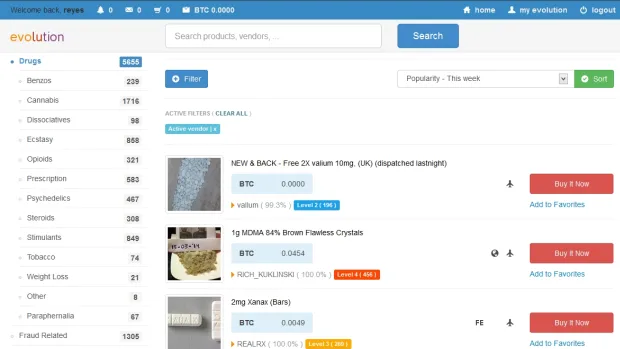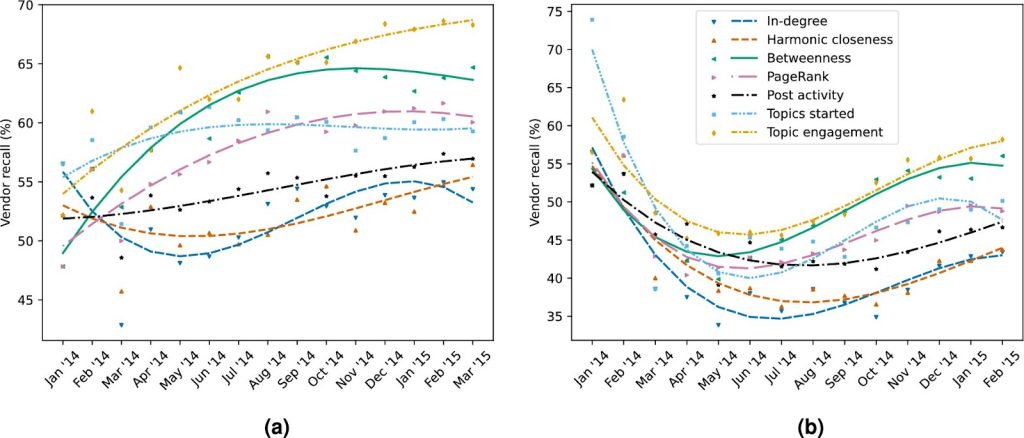A group of researchers from Leiden University came up with a way to predict which darknet vendors will turn into successful vendors on illegal online marketplaces, which could end up helping law enforcement track prominent figures on the darknet. The researchers presented their findings in a paper published in Scientific Reports.
Key Insights
- Researchers from Leiden University developed a predictive method for successful dark web vendors.
- Findings were published in Scientific Reports.
- Cryptomarkets on the dark web trade illegal goods, including drugs, weapons, and hacked data.
- Cryptocurrencies like Bitcoin are used for transactions to protect anonymity.
- The study analyzed data from Evolution, a major darknet market in 2014.
- Two key predictors were identified: topic engagement and betweenness centrality.
- Topic engagement measures user activity and response in forum discussions.
- Betweenness centrality measures a user’s role as an intermediary in the network.
- High topic engagement and betweenness centrality are indicators of successful sellers.
- The method could help law enforcement focus on potential key players.
- Early identification of emerging sellers can disrupt illicit activities.
Impact of Dark Web Markets on Society
Illegal online marketplaces, also known as Darknet Markets, are platforms on the darknet where drugs, weapons, hacked personal data, and images of child abuse are traded freely. These markets can’t be reached through normal internet browsers or regular search engines.
Using cryptocurrencies as a medium of exchange like Bitcoin protects anonymity between the buyers and sellers. This gives a big challenge to law enforcers, who have to move through such deep digital spaces in search of high-profile darknet vendors.
Illegal trades on the dark web have deep and far-reaching impacts on society. The growth of the drug trade fuels substance abuse and related health crises, while easy access to weapons escalates violence and criminal activity. The trading of hacked personal data results in identity theft, financial fraud, and privacy breaches that can destroy public trust in digital systems.
Additionally, the sharing of child abuse material continues to exploit and harm vulnerable individuals. Each of these activities undermines social stability, threatens public safety, and puts a heavy burden on law enforcement as they work to stop these hidden illegal operations.
Evolution Marketplace’s Harmful Legacy

A prediction method geared towards user activity in market forums was created, including a research team consisting of Ph.D. candidate Hanjo Boekhout, Professor Frank Takes, and Professor Arjan Blokland. In these forums, there are discussions among users and sellers; hence, the dataset could be very rich for analysis. The study drew from data that was collected back in 2014 from Evolution, at that time the biggest darknet market.
Evolution was one of the most popular darknet marketplaces in its prime, infamous for trading or selling illegal wares like drugs, weapons, and stolen private information. It was anonymous, so that made it a haven for illegal vendors. At the time of their takedown, the site’s huge user base and overall volume of illegal activities made it hard to handle.
Evolution’s impact was particularly harmful due to its role in enabling the widespread distribution of harmful substances, contributing to public health crises, and providing a marketplace for stolen personal information, which fueled identity theft and financial fraud. The existence and operation of these platforms undermine public safety and trust in digital systems, which shows the urgent need for effective methods to identify and apprehend key players within these illegal markets.
Topic Engagement and Betweenness Centrality
The researchers found two key predictors of the darknet vendors success: topic engagement and betweenness centrality. Topic engagement refers to the degree of activity a user can create within the context of discussions in a forum, measured by the frequency and volume of responses received by topics he or she initiates.
High topic engagement thus means creating a lot of interest and conversation, hence their influence and activeness over the community. The betweenness centrality, on the other hand, expresses users’ roles as an intermediary in the communication network, capturing their frequency of acting as a bridge between two different users in the network.
A user with high betweenness centrality does not post frequently, but every posting lets different parts of the network be connected through them. Those metrics, all together, should be able to shine a light on people who are engaged either in high levels of discussion or in key roles in connecting a forum’s different segments—both strong indicators of success as darknet vendors.

“Topic engagement proved to be a particularly strong predictor. Users with numerous responses to their forum topics often turned out to be successful sellers,” explained Boekhout. Conversely, betweenness centrality helped identify influential players who were less active on the forum. “Some sellers may not post as often, but when they do, they connect different parts of the network,” Boekhout added.
In that light, this predictive method would be of great help to law enforcement by enabling it to focus its investigations on relevant people that the algorithm identifies as those most likely to become key players in this illicit marketplace. As a result of the huge amount and high degree of complexity of data posted on these darkweb platforms, it becomes very difficult for the police to trace and apprehend all participants involved.
This will enable the police to concentrate efforts only on users with high values of topic engagement and betweenness centrality, for these are indicative of the potential for gaining great influence, and hence success, within the market.
“Our method can help to identify emerging sellers before they become major players,” said Blokland. This proactive, very forward-looking approach would let law enforcement intervene earlier, potentially disrupting the growth of illicit activities and mitigating harm caused by these illegal marketplaces.
The researchers hope that the work will draw attention from law enforcement agencies so that police scientists will have a chance to develop the method further and apply it in ongoing and future investigations into other darknet vendors.
These insights can be used in making the fight against illegal activities on the darkweb more effective, in that it disrupts the operations of key criminal figures before they achieve a lot of influence.

